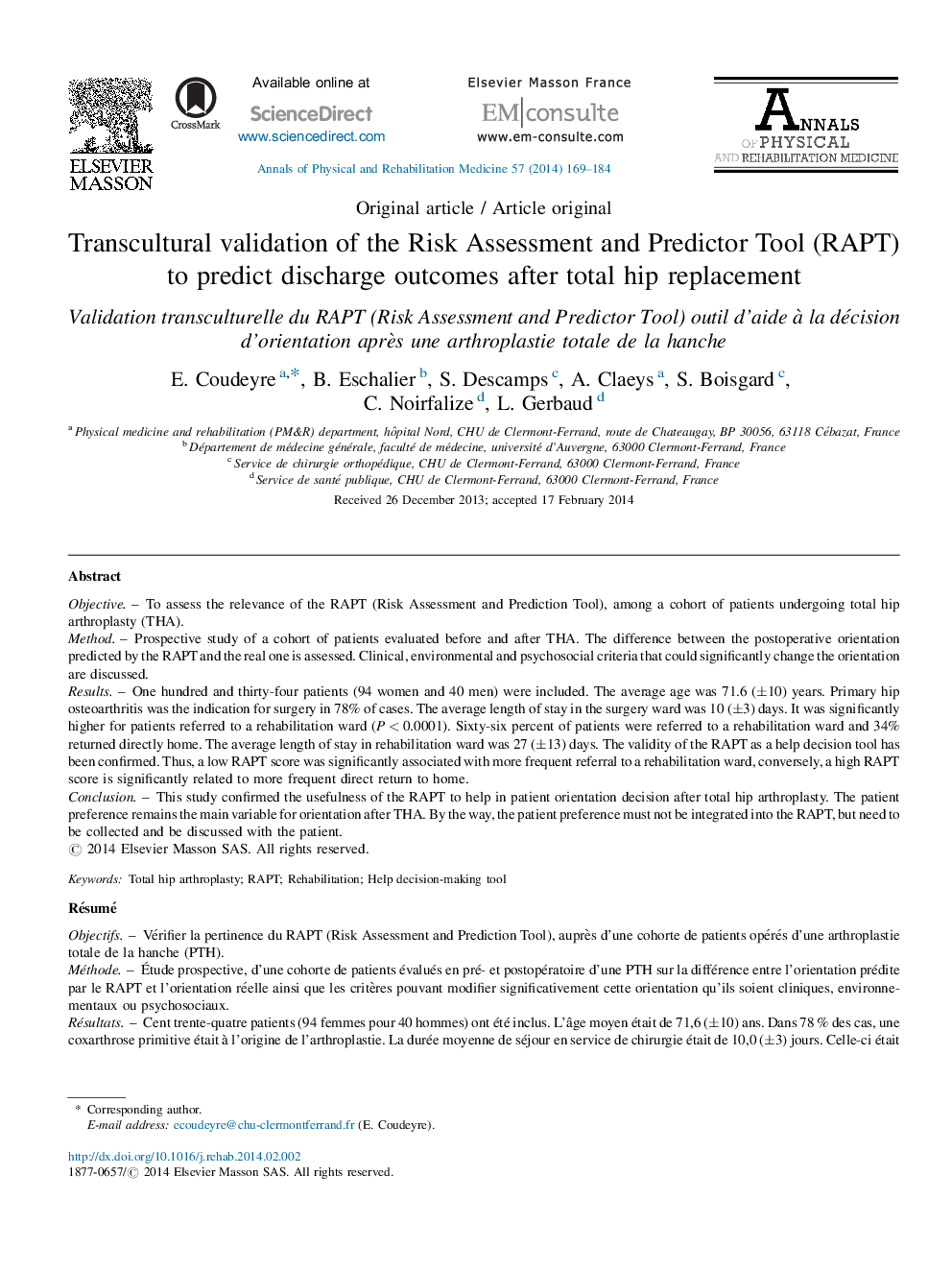| کد مقاله | کد نشریه | سال انتشار | مقاله انگلیسی | نسخه تمام متن |
|---|---|---|---|---|
| 6204020 | 1603309 | 2014 | 16 صفحه PDF | دانلود رایگان |

ObjectiveTo assess the relevance of the RAPT (Risk Assessment and Prediction Tool), among a cohort of patients undergoing total hip arthroplasty (THA).MethodProspective study of a cohort of patients evaluated before and after THA. The difference between the postoperative orientation predicted by the RAPT and the real one is assessed. Clinical, environmental and psychosocial criteria that could significantly change the orientation are discussed.ResultsOne hundred and thirty-four patients (94 women and 40 men) were included. The average age was 71.6 (±10) years. Primary hip osteoarthritis was the indication for surgery in 78% of cases. The average length of stay in the surgery ward was 10 (±3) days. It was significantly higher for patients referred to a rehabilitation ward (P < 0.0001). Sixty-six percent of patients were referred to a rehabilitation ward and 34% returned directly home. The average length of stay in rehabilitation ward was 27 (±13) days. The validity of the RAPT as a help decision tool has been confirmed. Thus, a low RAPT score was significantly associated with more frequent referral to a rehabilitation ward, conversely, a high RAPT score is significantly related to more frequent direct return to home.ConclusionThis study confirmed the usefulness of the RAPT to help in patient orientation decision after total hip arthroplasty. The patient preference remains the main variable for orientation after THA. By the way, the patient preference must not be integrated into the RAPT, but need to be collected and be discussed with the patient.
RésuméObjectifsVérifier la pertinence du RAPT (Risk Assessment and Prediction Tool), auprès d'une cohorte de patients opérés d'une arthroplastie totale de la hanche (PTH).MéthodeÃtude prospective, d'une cohorte de patients évalués en pré- et postopératoire d'une PTH sur la différence entre l'orientation prédite par le RAPT et l'orientation réelle ainsi que les critères pouvant modifier significativement cette orientation qu'ils soient cliniques, environnementaux ou psychosociaux.RésultatsCent trente-quatre patients (94 femmes pour 40 hommes) ont été inclus. L'âge moyen était de 71,6 (±10) ans. Dans 78 % des cas, une coxarthrose primitive était à l'origine de l'arthroplastie. La durée moyenne de séjour en service de chirurgie était de 10,0 (±3) jours. Celle-ci était significativement plus élevée pour les patients orientés vers un établissement de rééducation (p < 0,0001). Soixante-six pour cent des patients ont été adressés vers un établissement de rééducation et 34 % sont retournés directement à domicile. La durée de séjour moyenne en établissement de rééducation était de 27 (±13) jours. La validité du score RAPT comme outil d'aide à la décision dans l'orientation des patients a été confirmée. Ainsi, un score RAPT faible est significativement lié à une orientation plus fréquente vers un service de rééducation ; à l'inverse, un score RAPT élevé est significativement lié à un retour à domicile plus fréquent.ConclusionCette étude a confirmé l'utilité du RAPT pour aider le clinicien à prévoir l'orientation des patients après arthroplastie totale de hanche. Concernant la préférence du patient, qui reste la variable prépondérante dans l'orientation après PTH, il reste légitime de ne pas l'intégrer au RAPT mais de la recueillir pour la confronter à celui-ci pour décider de l'orientation postopératoire avec le patient.
Journal: Annals of Physical and Rehabilitation Medicine - Volume 57, Issue 3, April 2014, Pages 169-184